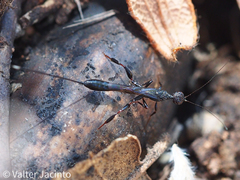European mantis
Mantis religiosa
Mantis religiosa, commonly known as the European mantis or "santateresa" in the Comunidad Valenciana, is an intriguing species of praying mantis that is widely distributed across Europe. Recognizable by its distinctive posture, the mantis holds its front legs in a position that resembles a posture of prayer.
This species is well-known for its unique appearance and behavior, making it a fascinating subject for entomologists and nature enthusiasts alike. Below are some key features of Mantis religiosa:
- Physical Description: Adult mantises can grow between 5 to 7.5 cm in length. They have a characteristic triangular head with bulging eyes that confer excellent stereoscopic vision, allowing them to accurately judge the distance and strike their prey with precision.
- Coloration: They often display a green or brown coloration, which provides them with effective camouflage among leaves and plants, aiding in both hunting and evasion from predators.
- Diet: Carnivorous by nature, they prey on a wide variety of insects. Utilizing their strong, spiny forelegs, they can quickly snatch their prey. They are known to exert a beneficial impact on pest populations.
- Reproduction: Females are notorious for practicing sexual cannibalism, sometimes consuming the male after mating. Females lay egg cases called oothecae in late summer; each can contain up to several hundred eggs, which hatch into nymphs in spring.
- Habitat: In the Comunidad Valenciana, they can typically be found in fields, gardens, and areas of wild vegetation, where they blend into the surroundings and hunt for insects.
The Mantis religiosa not only plays a significant role in controlling insect populations but is also a captivating creature due to its predatory skills and fascinating life cycle. Observing these mantises in their natural habitat is a true delight for those interested in the diverse fauna of the Comunidad Valenciana.







